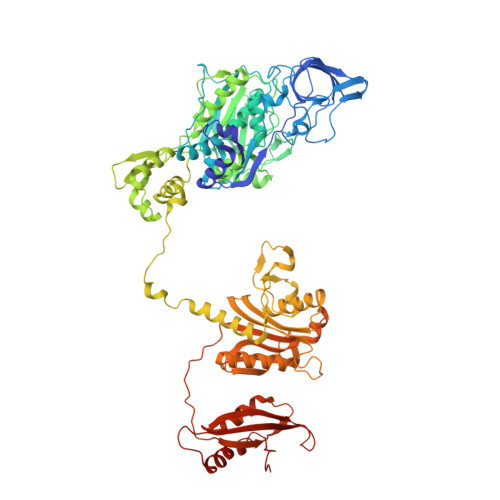Universal pathway for posttransfer editing reactions: Insights from the crystal structure of TtPheRS with puromycin.
Tworowski, D., Klipcan, L., Peretz, M., Moor, N., Safro, M.G.(2015) Proc Natl Acad Sci U S A 112: 3967-3972
- PubMed: 25775602
- DOI: https://doi.org/10.1073/pnas.1414852112
- Primary Citation of Related Structures:
4TVA - PubMed Abstract:
At the amino acid binding and recognition step, phenylalanyl-tRNA synthetase (PheRS) faces the challenge of discrimination between cognate phenylalanine and closely similar noncognate tyrosine. Resampling of Tyr-tRNA(Phe) to PheRS increasing the number of correctly charged tRNA molecules has recently been revealed. Thus, the very same editing site of PheRS promotes hydrolysis of misacylated tRNA species, associated both with cis- and trans-editing pathways. Here we report the crystal structure of Thermus thermophilus PheRS (TtPheRS) at 2.6 Å resolution, in complex with phenylalanine and antibiotic puromycin mimicking the A76 of tRNA acylated with tyrosine. Starting from the complex structure and using a hybrid quantum mechanics/molecular mechanics approach, we investigate the pathways of editing reaction catalyzed by TtPheRS. We show that both 2' and 3' isomeric esters undergo mutual transformation via the cyclic intermediate orthoester, and the editing site can readily accommodate a model of Tyr-tRNA(Phe) where deacylation occurs from either the 2'- or 3'-OH. The suggested pathway of the hydrolytic reaction at the editing site of PheRS is of sufficient generality to warrant comparison with other class I and class II aminoacyl-tRNA synthetases.
- Department of Structural Biology, Weizmann Institute of Science, Rehovot 7610001, Israel;
Organizational Affiliation:



















